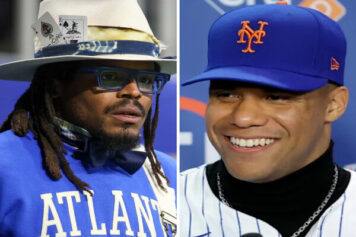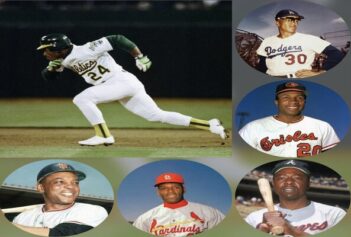Incidents of fans getting hit and injured by baseballs at MLB games has been increasing each year, but MLB has refused to mandate that its ballparks install protective netting throughout the stadium.
While all 30 teams expanded their protective netting before the 2018 season, there have still been calls for further safety measures in ballparks. And balls traveling faster than cars are still finding body parts on human beings.
Everyone, from old men to young toddlers have been getting hit by baseballs flying off the bats of world-class athletes. MLB Commissioner Rob Manfred has maintained that the choice to put any kind of extended netting in the stadium is a club to club decision.
The Chicago White Sox, however, did in less than two weeks what other teams aren’t willing to do. Just protect the entire park. I’d leave the outfield and upper deck alone though BTW.
U.S. Senator Dick Durbin, (D) Illinois, urging Major League Baseball to extend protective netting to the left and right field corners of stadiums to reduce the number of fan injuries due to being hit by balls. Congratulated White Sox for moving to extend netting this season.
— Doug Wolfe – WAND TV (@WANDTVDoug) July 9, 2019
Common sense would tell you that it should be mandatory, but baseball is one of the sports least willing to change tradition, even if it means better safety for the fans and doesn’t detract from the experience of going to the game. Baseball is also a sport that listens to the demands of its fans and many don’t want the extra netting, which will undoubtedly obstruct their view at times.
A recent ESPN poll, however, shows that 78 percent of the fans are in favor of teams instituting more safety netting around the ballparks for protection.
Baseball is facing renewed scrutiny over the safety of its spectators after recent incidents involving fans being hit by foul balls. (From @NewsHour) https://t.co/0JVTqlzqTc
— PBS (@PBS) July 11, 2019
Brooks Boyer, Senior VP of sales and marketing for The Sox said when it comes down to it, it’s just common sense.
“It’s always safety first when it comes to baseball. When you look at the state of the game at this point and time, you’ve got grown men who are the best athletes in the world at doing what they’re doing. You’ve got balls coming off the bat at a much quicker (speed) and we have all these stats that show us what exit velocity looks like and when you have the technology we have today when people are checking scores or any social media, not everybody is paying attention all the time.
When we extended our netting a few years back to the end of the dugouts, we thought we had taken the speed out of the game at that point for people who would have a clear view at the game, but the balls are still coming at a quick rate and we’ve seen (people get hurt) too many times.”
A typical foul ball enters the stands at speeds between 100 and 110 miles per hour, according to a study that appeared in a 2018 William & Mary Law Review.
That means a fan seated 60 feet from home plate has four-tenths of a second to react — if they are paying close attention to the action.
“Fans today frequently sit more than 20 percent closer to home plate than was the case throughout most of the 20th century,” said study author Nathaniel Grow, an associate professor of business law and ethics at Indiana University’s Kelley School of Business.
“Many foul ball-related injuries could easily be avoided through the installation of additional safety netting at little cost to the team,” the study authors concluded.
The Chicago White Sox are extending protective netting all the way to the foul poles, as @CST_soxvan reported.
One down, 29 to go.
Your move, every other team. Go ahead and be the one that isn't prioritizing fan safety.
— Jeff Passan (@JeffPassan) June 18, 2019
“When we saw everything that was happening around major league baseball,” the White Sox rep added, we thought it was necessary to make sure that Guaranteed Rate Field was the safest experience for our fans”
“When you combine that with an increase in the speed with which baseballs are being hit into the stands, fans have less time to avoid errant balls or bats heading in their direction,” Grow elaborated.
In addition to all of those valid reasons, people just don’t pay attention anymore at games. Technology has taken control of everyone and if people are risking their lives driving while texting at record rates, don’t expect them to be protecting themselves during a baseball game anymore. It’s time for baseball to save the fans from themselves more than anything.
First Baseball Stadium Death In 50 Years
If the death of a 79-year-old woman at Dodger Stadium last August doesn’t compel teams to put up the netting than nothing short of a rule will.
Via Post: “”Erwin Goldbloom was at a game at Dodger Stadium last August with his wife, Linda, when she was struck in the head by a foul ball and later died at the hospital of a fatal brain injury…the team offered to hold a moment of silence for Linda before a 2019 game, but Goldbloom declined, asking instead for something more tangible.
“We don’t need their sympathy. We want action,” Goldbloom told ESPN’s “Outside the Lines” in late March of 2019. “If they agree to make changes to improve safety for fans, then I’ll go down there.”
The couple was sitting on the first-base side of home plate for the Dodgers’ Aug. 25 game last season. A Padres batter hit a foul ball that cleared the protective netting and hit Linda, 79. She died four days later, though it went largely out of the public eye until ESPN confirmed in February from the coroner’s report that her cause of death was “acute intracranial hemorrhage due to history of blunt force trauma” from the baseball hitting her.
According to the Washington Post, it was the first time in 50 years that someone died at an MLB stadium from being hit by a baseball. That’s one more time too many.
MLB is stubborn when it comes to protecting tradition, but finally, the Chicago White Sox have taken the lead in protecting fans and the conscience of players, other stadiums would be wise to follow suit before someone else dies.



